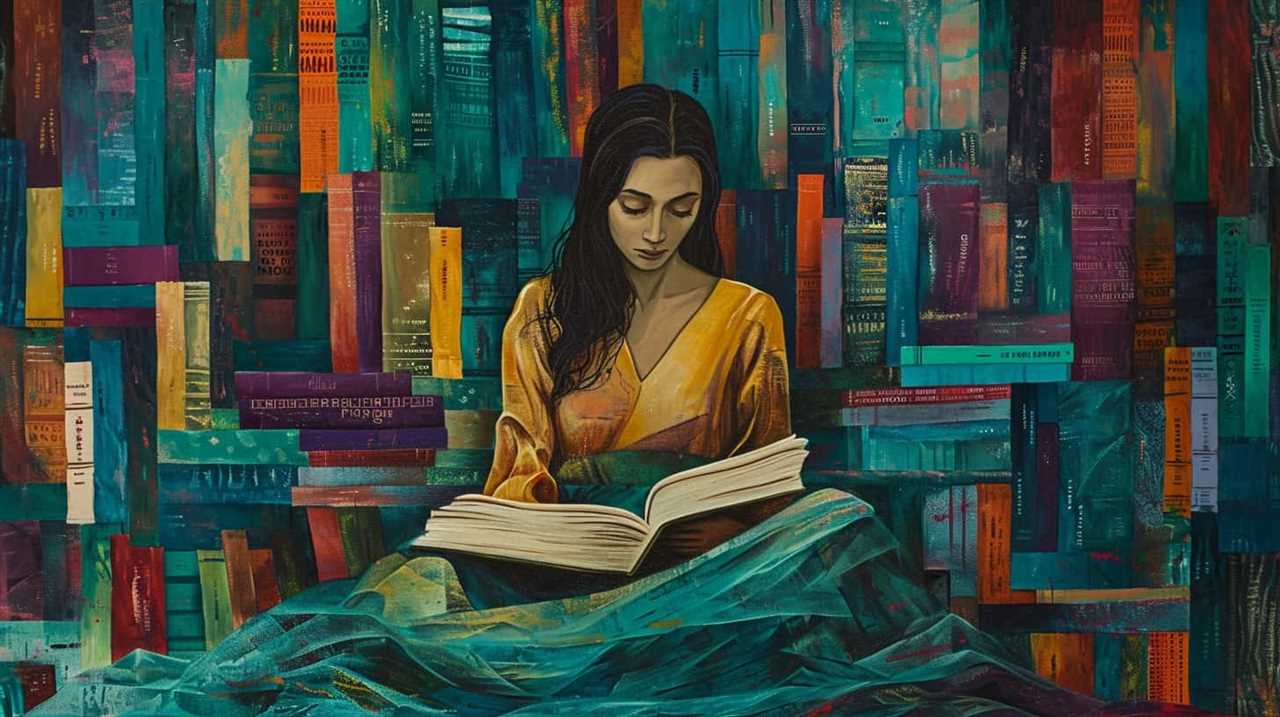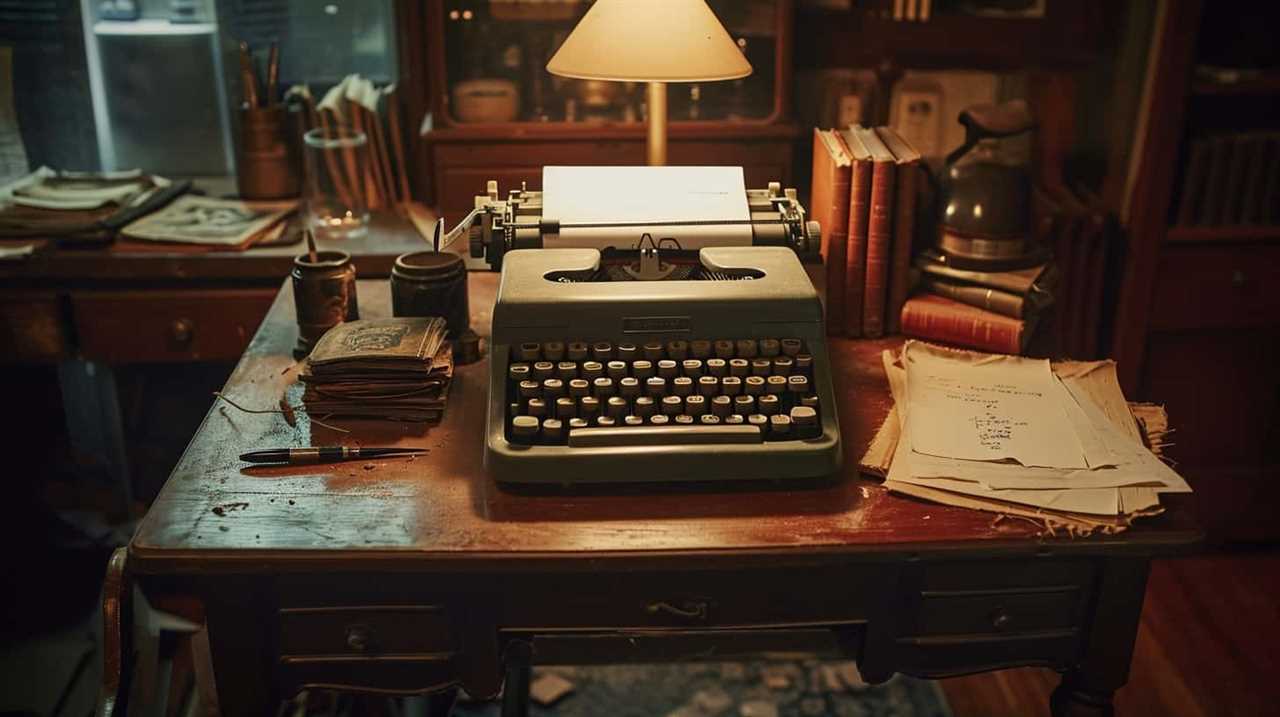What insights do famous writers have on the art of writing?
We delved into the wisdom of Stephen King, J.K. Rowling, Ernest Hemingway, Maya Angelou, Neil Gaiman, John Steinbeck, Sylvia Plath, F. Scott Fitzgerald, and Jane Austen to uncover their unique perspectives on the art of writing.
In this exploration, we sought guidance and inspiration from these literary giants, renowned for their innovative storytelling and captivating prose.
By examining their insights, we hope to uncover fresh ideas and approaches that will ignite our own creativity.

Join us as we embark on a journey through the minds of these literary luminaries, discovering how they honed their craft and continue to shape the world of literature.
Key Takeaways
- Stephen King emphasizes the importance of having a disciplined writing routine and the need for extensive editing in the writing process.
- J.K. Rowling highlights the significance of extensive outlining and attention to detail in crafting a story.
- Ernest Hemingway’s minimalist writing style and use of symbolism have had a profound impact on modern writing.
- Maya Angelou encourages writers to draw from personal experiences and emphasizes the importance of revision in refining one’s work.
Stephen King’s Advice on Writing Craft
Stephen King’s advice on writing craft offers valuable insights for aspiring authors. Known for his prolific output and mastery of the horror genre, King has shared his writing routine and emphasized the importance of editing in creating compelling stories.
King’s writing routine is disciplined and consistent. He believes in writing every day, setting a goal of 2,000 words per day. This commitment to regular practice allows him to maintain momentum and stay connected to his stories. By immersing himself in the writing process, King is able to tap into his creativity and produce engaging narratives.
However, King also recognizes that the first draft is just the beginning. He emphasizes the crucial role of editing in the writing process. According to King, the real work of writing happens during revision. He advises writers to cut unnecessary words, tighten sentences, and eliminate extraneous details. By honing their writing through careful editing, authors can create polished and impactful stories.

Transitioning into J.K. Rowling’s perspective on writing craft, it’s interesting to note that while King emphasizes the importance of editing, Rowling has her own unique insights to offer.
J.K. Rowling’s Perspective on Writing Craft
Moving on to J.K. Rowling’s perspective on writing craft, we gain valuable insights into her approach and techniques. Rowling’s writing process is known for its meticulous planning and attention to detail. She believes in outlining her stories extensively before diving into the actual writing. This allows her to have a clear vision of the plot and the characters, ensuring a coherent and well-structured narrative.
The influence of Rowling’s writing style can be seen in her ability to create rich and immersive worlds. She excels at building intricate magical systems and crafting complex characters that resonate with readers. Her attention to detail extends beyond the plot and characters, as she often includes hidden clues and foreshadowing throughout her books, adding depth and intrigue to the story.
Rowling’s approach to writing craft emphasizes the importance of perseverance and determination. She famously wrote the first Harry Potter book while facing numerous rejections. Her ability to push through adversity and continue refining her work is a testament to her unwavering dedication to the craft.

Transitioning into Ernest Hemingway’s insights on writing craft, we can explore another renowned author’s unique perspective on the art of storytelling.
Ernest Hemingway’s Insights on Writing Craft
When it comes to discussing writing craft, Ernest Hemingway’s name can’t be ignored. His distinctive writing techniques, characterized by concise and powerful prose, continue to influence writers today.
Hemingway’s advice on writing, such as his emphasis on simplicity and avoiding unnecessary words, has had a significant impact on the literary world. His legacy as a master storyteller and his contributions to the craft of writing are unquestionable.
Hemingway’s Writing Techniques
In our exploration of renowned authors’ insights on writing craft, we delve into the writing techniques of Ernest Hemingway, a master of his craft.

Hemingway is well-known for his minimalist style, which emphasizes brevity and simplicity in his prose. His use of short, declarative sentences and sparse description creates a sense of immediacy and allows readers to fill in the gaps with their own interpretations.
Another hallmark of Hemingway’s writing is his use of symbolism. He often employs symbolic imagery to convey deeper meanings and emotions, allowing readers to engage with the text on a more profound level.
Through his unique combination of minimalist style and symbolism, Hemingway’s writing continues to inspire and captivate readers with its innovative approach to storytelling.
Impact of Hemingway’s Advice
As we delve into the impact of Hemingway’s advice on writing craft, we can see how his insights continue to shape the way we approach storytelling.

Hemingway’s influence on modern writing is undeniable, as his unique writing style revolutionized the literary world. His concise and minimalist prose, characterized by short sentences and straightforward language, challenged the traditional norms of writing at the time.
Hemingway believed in the power of omission, using only essential details to convey meaning and evoke emotions. This approach not only made his writing more accessible and engaging, but it also paved the way for future writers to experiment with brevity and precision.
Hemingway’s advice on writing craft, emphasizing clarity and simplicity, has inspired countless authors to embrace a more innovative and impactful style of storytelling.
Hemingway’s Legacy in Writing
After exploring the impact of Hemingway’s advice on writing craft, we can confidently assert that his insights continue to shape the way we approach storytelling. Hemingway’s influence in the literary world is undeniable, and his writing style is still revered today for its simplicity, clarity, and precision.

Here are three ways Hemingway’s legacy in writing continues to inspire and guide us:
- Economy of language: Hemingway believed in saying more with less. His sparse prose and minimalist approach taught us the power of brevity and the importance of choosing each word carefully.
- Realism and authenticity: Hemingway’s writing was grounded in reality, often drawing from his own experiences. He showed us the value of authenticity in storytelling and the impact it can have on readers.
- Hemingway’s iceberg theory: Hemingway’s iceberg theory emphasized the importance of subtext and what’s left unsaid. This approach encourages readers to actively participate in the story, making it a more engaging and immersive experience.
Hemingway’s legacy in writing continues to shape and inspire us, reminding us of the timeless principles of good storytelling.
Maya Angelou’s Wisdom on Writing Craft
We can learn a great deal about the writing craft from Maya Angelou. Her writing journey and process provide valuable insights for aspiring writers.
Angelou believed that writing should come from the heart and be infused with personal experiences and emotions. She emphasized the importance of authenticity and encouraged writers to find their unique voice.

Angelou’s writing process involved discipline and dedication. She’d often wake up early in the morning and start writing, immersing herself in the flow of words. She believed in the power of revision and would go through multiple drafts to refine her work.
Angelou also emphasized the significance of reading, stating that it helps writers expand their vocabulary and gain inspiration. She believed in the power of storytelling to connect people and bring about social change.
Angelou’s wisdom reminds us that writing isn’t just about the words on the page, but about the impact it can have on others. Her innovative approach to storytelling continues to inspire writers around the world.
Neil Gaiman’s Thoughts on Writing Craft
Neil Gaiman, the acclaimed author known for his imaginative storytelling, offers valuable lessons from his career that aspiring writers can learn from. Here are three key takeaways from Neil Gaiman’s thoughts on writing craft:

- Embrace your unique writing style: Gaiman encourages writers to embrace their individual voices and not be afraid to experiment with different genres and styles. He believes that writers should focus on telling stories in a way that only they can, without worrying about fitting into a specific mold.
- Write what you love: According to Gaiman, the most important thing is to write what you love and are passionate about. He advises writers to pursue projects that excite them, as it won’t only make the writing process more enjoyable but also resonate with readers who share the same passion.
- Perseverance is key: Gaiman emphasizes the importance of perseverance in a writing career. He shares that rejection and failure are inevitable, but it’s essential to keep writing and improving. Gaiman’s own journey, filled with setbacks and challenges, serves as a reminder that success often comes to those who persist.
Toni Morrison’s Reflections on Writing Craft
When it comes to exploring Toni Morrison’s reflections on writing craft, we’re eager to uncover her unique techniques and insights.
Morrison’s ability to seamlessly weave together storytelling and social commentary has made her a literary icon, and we can expect her reflections to offer valuable lessons on craft.
Morrison’s Writing Techniques
Toni Morrison’s reflections on writing craft shed light on her unique approach and effective techniques. Her writing style, influenced by her literary idols such as William Faulkner and Gabriel Garcia Marquez, is characterized by its poetic prose and richly layered storytelling. Morrison’s ability to seamlessly blend historical events with elements of magical realism captivates readers and challenges traditional narrative structures.
Symbolism: Morrison masterfully employs symbols to convey deeper meanings and evoke powerful emotions within her readers. Through symbols like the blue dress in ‘The Bluest Eye’ or the haunted house in ‘Beloved,’ she invites us to explore themes of identity, trauma, and memory.

Intertextuality: Morrison’s works are interwoven with references to other literary works, creating a dialogue between her own storytelling and the larger literary canon. This intertextuality adds depth and complexity to her narratives, inviting readers to engage with multiple layers of meaning.
Language and Rhythm: Morrison’s writing is known for its lyrical quality and rhythmic cadence. Her use of repetition, alliteration, and unique syntax creates a distinctive musicality that enriches the reading experience.
With these techniques, Morrison transforms her stories into immersive and thought-provoking journeys that continue to resonate with audiences.
Craft Insights From Morrison
As we delve into the craft insights from Toni Morrison, a renowned author, we gain valuable perspective on the art of writing. Morrison’s writing style is characterized by its richness and depth, often exploring themes of identity, race, and memory.

She masterfully weaves together vivid imagery and poetic language, creating a sensory experience for the reader. Morrison’s literary influences can be seen in her work, with nods to authors such as William Faulkner and Gabriel Garcia Marquez.
She combines elements of magical realism with a distinct African-American storytelling tradition, creating a unique and powerful narrative voice. Morrison’s craft insights remind us of the importance of storytelling as a means of exploring the human experience and challenging societal norms.
Impact of Morrison’s Advice
Exploring the impact of Morrison’s advice on writing craft, we find valuable insights that shape our understanding of storytelling and challenge conventional norms. Morrison’s reflections have had a profound impact on contemporary literature, influencing aspiring authors and pushing the boundaries of traditional narratives.
Here are three lessons we can learn from Morrison’s wisdom:

- Embrace the complexity of human experiences: Morrison reminds us to delve into the nuances of the human condition, exploring the depths of emotions and the intricacies of relationships. By doing so, we can create authentic and relatable characters that resonate with readers.
- Challenge dominant narratives: Morrison encourages us to question and challenge the dominant narratives that perpetuate inequality and injustice. Through our writing, we’ve the power to give voice to the marginalized and reshape the storytelling landscape.
- Emphasize language and style: Morrison’s meticulous attention to language and her poetic prose inspire us to craft our sentences with precision and beauty. By mastering our craft, we can create a unique and compelling reading experience for our audience.
Morrison’s advice continues to shape the literary world, offering invaluable lessons for aspiring authors and pushing the boundaries of storytelling.
George Orwell’s Observations on Writing Craft
We have found that George Orwell offers valuable insights on the craft of writing. Orwell, known for his political writing, had a keen eye for detail and a knack for capturing the essence of his subjects. His observations on the craft of writing are both concise and imaginative, making them perfect for an audience that desires innovation.
One aspect of Orwell’s writing that stands out is his ability to create vivid and memorable characters. He believed that characters should be relatable and believable, much like those in Hemingway’s writing style. Orwell understood the importance of creating characters that readers could connect with on an emotional level, as it allows them to become fully immersed in the story.
Orwell also stressed the significance of clarity and precision in writing. He believed that writers should strive to convey their ideas in a straightforward manner, avoiding unnecessary jargon or convoluted language. By doing so, writers can ensure that their message is easily understood and resonates with their audience.

Virginia Woolf’s Musings on Writing Craft
When it comes to writing craft, Virginia Woolf’s insights are truly invaluable. Her advice on finding one’s own unique voice and experimenting with different narrative techniques has had a profound impact on modern literature.
As aspiring writers, we can learn so much from her emphasis on the importance of authenticity and pushing the boundaries of traditional storytelling.
Woolf’s Writing Advice
In our exploration of renowned authors’ perspectives on writing craft, we delve into Virginia Woolf’s insightful advice regarding the art of writing. Woolf, influenced by Hemingway’s minimalist style, embraced modern writing techniques to create her own unique literary voice.
Here are three key points from Woolf’s writing advice:

- Embrace simplicity: Woolf believed in the power of brevity and clarity. She encouraged writers to strip away unnecessary words and focus on conveying their message concisely.
- Experiment with form: Woolf challenged traditional narrative structures and encouraged writers to explore innovative ways of storytelling. She believed that experimentation with form could lead to groundbreaking literary works.
- Dive into the interior world: Woolf emphasized the importance of exploring the inner lives of characters and the complexities of human emotions. She believed that delving into the interior world could create a deeper connection between the reader and the story.
Woolf’s writing advice continues to inspire writers to push the boundaries of creativity and explore new possibilities in their craft.
Impact on Modern Literature
Continuing our exploration of renowned authors’ perspectives on writing craft, let’s delve into the impact of Virginia Woolf’s musings on modern literature.
Woolf’s unique insights and experimental writing style have greatly influenced the evolution of modern literature. Her groundbreaking works, such as ‘To the Lighthouse’ and ‘Mrs. Dalloway,’ challenged traditional narrative structures and pushed the boundaries of what was considered acceptable in literature.
Woolf’s introspective and stream-of-consciousness approach gave contemporary authors the freedom to experiment with form and explore the depths of human consciousness. Today, many writers draw inspiration from Woolf’s innovative techniques and her exploration of themes such as gender, identity, and the complexities of human experience.

Woolf’s influence can be seen in the works of contemporary authors who continue to push the boundaries of literature, creating bold and innovative narratives that resonate with modern readers.
Relevance to Aspiring Writers
Aspiring writers can gain valuable insights from Virginia Woolf’s musings on writing craft, which have had a profound impact on modern literature. Woolf’s thoughts on the craft of writing can be particularly relevant to aspiring writers who often struggle with their own obstacles and challenges.
Here are three key ideas from Woolf’s musings that can help aspiring writers overcome their struggles:
- Embrace experimentation: Woolf encouraged writers to break free from traditional narrative structures and explore innovative ways of storytelling. Aspiring writers can learn from this and experiment with different writing styles, techniques, and perspectives to find their unique voice.
- Dive into the depths of consciousness: Woolf believed in delving into the inner thoughts and emotions of characters. Aspiring writers can strive to deepen their understanding of their characters’ psyche, bringing authenticity and depth to their stories.
- Embrace the power of language: Woolf’s writing was characterized by her exquisite use of language. Aspiring writers can focus on honing their language skills, exploring new vocabulary, and crafting precise and evocative prose.
Harper Lee’s Inspiration on Writing Craft
Harper Lee’s insights on writing craft offer valuable guidance for aspiring authors. Lee, influenced by the likes of Hemingway and Plath, brings a unique perspective to the craft. Like Hemingway, she believed in the power of brevity and simplicity. Her writing style, reminiscent of Plath’s, showcased a raw emotional depth that resonated with readers. Lee’s ability to capture the essence of a character with just a few well-chosen words is a testament to her mastery of the craft.

She emphasized the importance of creating relatable characters, drawing inspiration from the people around her. Lee believed that a strong character could carry a story, captivating readers and leaving a lasting impact. She encouraged aspiring authors to observe the world and draw from their own experiences, using them as a foundation for their storytelling.
Transitioning to Mark Twain’s tips on writing craft, we can see how his wit and humor shaped his writing. Twain believed in the power of language to engage and entertain readers. His use of vernacular and regional dialects added authenticity to his work, creating a vivid and immersive reading experience. Twain’s tips on crafting dialogue and creating memorable settings will be explored in the next section.
Mark Twain’s Tips on Writing Craft
Mark Twain’s advice on writing craft provides valuable insights for authors. His unique perspective and innovative approach have greatly influenced the literary world. Here are three key tips from Mark Twain that can help authors improve their writing craft:
- Embrace simplicity: Twain believed in the power of simplicity in writing. He encouraged authors to use clear and concise language, avoiding unnecessary complexity. This approach resonates with Hemingway’s writing style, which also prioritized simplicity and directness.
- Capture authenticity: Twain emphasized the importance of writing authentically. He believed that genuine experiences and emotions are what connect readers to a story. By infusing their writing with honesty and sincerity, authors can create a profound impact on their audience, just like Twain did with his works.
- Harness humor: Twain was renowned for his wit and humor. He recognized the power of laughter in engaging readers and conveying messages effectively. Adding humor to writing not only entertains but also helps to create a memorable and enjoyable reading experience.
Mark Twain’s influence on the literary world extends far beyond his own time. His tips on simplicity, authenticity, and humor continue to inspire and guide authors in their craft. By incorporating these principles into their writing, authors can create works that captivate and resonate with readers, just as Twain’s works have done for generations.

Margaret Atwood’s Guidance on Writing Craft
Moving on to Margaret Atwood’s guidance on writing craft, her insights offer valuable perspectives for authors looking to enhance their skills and storytelling abilities.
Atwood, a renowned Canadian author, draws inspiration from a variety of sources, including Ernest Hemingway’s writing style and her own unique influences.
Hemingway’s minimalist approach to writing has had a profound impact on Atwood’s craft. She believes in the power of brevity and simplicity, using only the essential words to convey her message. This economy of language allows her stories to have a greater impact on readers, as they’re forced to engage actively in the narrative.
Additionally, Atwood’s craft is influenced by her diverse range of interests and experiences. She draws inspiration from mythology, literature, and current events, weaving them seamlessly into her stories. This multidisciplinary approach adds depth and richness to her writing, making it both thought-provoking and innovative.

John Steinbeck’s Suggestions on Writing Craft
Continuing our exploration of renowned authors’ insights on writing craft, let’s delve into John Steinbeck’s suggestions for honing one’s writing skills. As an author known for his vivid storytelling, Steinbeck had a unique perspective on the art of writing. Here are three key takeaways from his approach:
- Embrace Hemingway’s writing style: Steinbeck admired Ernest Hemingway’s concise and straightforward writing style. He believed that brevity and simplicity were essential in conveying powerful emotions and capturing readers’ attention. By adopting Hemingway’s minimalist approach, writers can create impactful narratives that resonate with the audience.
- Master Steinbeck’s storytelling techniques: Steinbeck was a master at creating rich, immersive worlds through his storytelling. He emphasized the importance of vivid descriptions, sensory details, and authentic dialogue to bring characters and settings to life. By honing these techniques, writers can transport readers to different times and places, captivating their imaginations.
- Emphasize the human experience: Steinbeck believed that the heart of any story lies in the human experience. He urged writers to delve deep into the complexities of human emotions, relationships, and struggles. By exploring the depths of human nature, writers can create stories that touch the hearts of readers and leave a lasting impact.
With Steinbeck’s guidance, writers can refine their craft and create narratives that resonate with readers on a profound level.
Now, let’s turn our attention to Sylvia Plath’s experiences with writing craft.
Sylvia Plath’s Experiences With Writing Craft
When it comes to Sylvia Plath’s experiences with writing craft, we’re intrigued by her unique creative process, the writing techniques she employed, and the profound impact it had on her work.

Plath’s ability to seamlessly merge personal experiences with vivid imagery and poetic language allowed her to create powerful and emotionally charged pieces.
Exploring these aspects of her writing journey provides valuable insights into the artistry behind her literary achievements.
Plath’s Creative Process
During our research on renowned authors’ perspectives on writing craft, we discovered valuable insights into Sylvia Plath’s creative process and her experiences with honing her craft. Plath’s writing process was influenced by various factors, including her personal struggles, literary influences, and her commitment to honing her skills.
Here are three key aspects of Plath’s creative process:

- Personal Struggles: Plath’s writing was deeply influenced by her personal experiences, including her battles with mental health issues and her tumultuous relationships. She used writing as a way to explore and make sense of her emotions, often drawing from her own pain and struggles to create powerful and poignant works.
- Literary Influences: Plath was influenced by several writers, including Emily Dickinson and Virginia Woolf. She admired their use of language and their ability to convey complex emotions. Plath incorporated elements of their styles into her own writing, experimenting with form and imagery to create unique and evocative pieces.
- Commitment to Craft: Plath was known for her dedication to her craft. She constantly sought to improve her writing skills, attending writing workshops and seeking feedback from fellow writers. She believed in the importance of revision and refining her work, often spending hours meticulously editing her poems and prose to achieve the desired effect.
Plath’s creative process was a dynamic and personal journey, shaped by her unique experiences and literary influences. Her commitment to honing her craft and her willingness to explore her own emotions and struggles through writing contributed to the powerful and enduring impact of her work.
Writing Techniques Used
In our exploration of renowned authors’ perspectives on writing craft, we delve into the writing techniques employed by Sylvia Plath in her own experiences with honing her craft.
Plath was known for her dedication to improving her writing skills, and she often turned to writing exercises to challenge herself and push the boundaries of her creativity. Through these exercises, she’d experiment with different storytelling techniques, such as using vivid imagery, creating complex characters, and playing with narrative structure.
Plath’s commitment to honing her craft through these techniques had a profound impact on her work, allowing her to develop a unique voice and produce deeply evocative and emotionally resonant literature.

Now, let’s explore how these techniques influenced her writing style and themes.
Impact on Her Work
We frequently witnessed how Sylvia Plath’s experiences with writing craft profoundly influenced her work. Her experimentation with different writing techniques had a significant impact on her creativity and storytelling. Here are three ways in which Plath’s experiences shaped her writing:
- Language as a tool: Plath’s exploration of language allowed her to create vivid and powerful imagery in her poetry and prose. Her meticulous attention to detail and use of metaphors enriched her storytelling, immersing readers in her emotional landscapes.
- Personal experiences as inspiration: Plath drew heavily from her own life experiences, infusing her work with raw emotions and introspection. Her ability to translate her personal struggles into universal themes resonated deeply with readers, giving her writing an intimate and relatable quality.
- Breaking literary conventions: Plath defied traditional narrative structures and experimented with unconventional forms of storytelling. Her willingness to push boundaries and challenge societal norms brought a fresh perspective to her work, captivating audiences and leaving a lasting impact.
Through her experiences with writing craft, Plath’s creativity flourished, and her unique approach to storytelling continues to inspire and influence writers today.
F. Scott Fitzgerald’s Views on Writing Craft
Our exploration of F. Scott Fitzgerald’s views on writing craft reveals that he believed in the power of storytelling to transport readers into a vivid and captivating world. As a writer, Fitzgerald was influenced by the literary styles of his contemporaries, including Ernest Hemingway. While Hemingway favored a concise and straightforward writing style, Fitzgerald embraced a more poetic and lyrical approach.

Fitzgerald understood that crafting a compelling story required more than just beautiful prose. He believed that a writer’s duty was to create characters that were relatable and complex, allowing readers to connect with their struggles and triumphs. By infusing his narratives with social commentary and exploring the complexities of human relationships, Fitzgerald aimed to engage his audience on a deeper level.
In addition to Hemingway, Fitzgerald drew inspiration from a wide range of literary influences. He admired the works of authors like Joseph Conrad and Henry James, whose intricate storytelling and exploration of psychological themes resonated with him. Fitzgerald believed in the importance of studying and learning from the great writers who came before him, constantly seeking to improve his craft.
Transitioning to the subsequent section about Jane Austen’s observations on writing craft, it’s clear that renowned authors throughout history have each had their own unique perspectives on the art of storytelling.
Jane Austen’s Observations on Writing Craft
Transitioning from F. Scott Fitzgerald’s views on writing craft, it’s evident that renowned authors throughout history have each offered their unique perspectives on the art of storytelling, including Jane Austen’s observations. As we delve into Jane Austen’s writing style and character development, we’re captivated by her ability to create vivid worlds and complex individuals. Here are three key aspects of Austen’s craft:

- Subtle wit and social commentary: Austen’s writing style is characterized by her clever and satirical observations of the society she lived in. Through her keen eye for detail and sharp wit, she masterfully exposes the flaws and absurdities of the upper class, while simultaneously entertaining her readers.
- Delicate balance of realism and romance: Austen’s novels are known for their realistic portrayals of everyday life, while also weaving in elements of romance and love. By grounding her stories in relatable experiences, she creates a connection between her characters and readers, making her novels timeless and enduring.
- Complex and relatable characters: Austen’s character development is unparalleled. Her protagonists aren’t only well-rounded and multi-dimensional, but they also face relatable struggles and conflicts. Austen’s ability to capture the intricacies of human nature allows readers to resonate with her characters on a deeply personal level.
Frequently Asked Questions
How Did Sylvia Plath’s Personal Experiences Shape Her Approach to Writing Craft?
Sylvia Plath’s personal experiences deeply influenced her writing craft. Her raw emotions and struggles with mental health shaped her unique writing techniques, allowing her to create powerful and innovative works of literature.
What Are F. Scott Fitzgerald’s Thoughts on the Role of Symbolism in Writing?
- Scott Fitzgerald believed that symbolism played a crucial role in writing. He saw it as a way to add depth and meaning to the story, allowing readers to interpret and engage with the text on a deeper level.
Can Jane Austen’s Observations on Writing Craft Be Applied to Modern Literature?
Applying classic techniques to contemporary storytelling is a challenge. However, Jane Austen’s observations on writing craft possess enduring wisdom. Her insights on character development, social commentary, and subtlety can still be valuable tools for modern literature.
How Did John Steinbeck’s Suggestions on Writing Craft Impact His Own Writing Style?
John Steinbeck’s suggestions on writing craft greatly impacted his own writing style. His emphasis on authenticity and vivid imagery influenced his use of descriptive language and character development, making his work truly immersive and evocative.
What Is Margaret Atwood’s Guidance on Developing Complex, Multidimensional Characters in Writing?
Margaret Atwood’s guidance on developing complex characters is invaluable. She provides techniques for character development that help us create multidimensional characters, making our writing more imaginative and precise.

Are the Writing Techniques and Tips from Romance Novelists Applicable to All Types of Writing?
Many writing techniques and tips from romance novelists on life are applicable to all types of writing. The skillful use of sensory language, deep character development, and emotional storytelling can enhance any genre. Additionally, the ability to create compelling narratives and evoke strong emotions is valuable for all writers.
Conclusion
In conclusion, renowned authors have shared their invaluable insights on writing craft. From Stephen King’s practical advice to J.K. Rowling’s perspective on imagination, Ernest Hemingway’s simplicity to Maya Angelou’s wisdom, each author brings a unique and inspiring contribution to the craft.
Their words serve as a guiding light for aspiring writers, reminding us of the power of words and the importance of honing our craft. As we embark on our own writing journeys, let’s embrace their wisdom and strive for greatness in our own unique voices.
Lauren’s talent in writing is matched by her passion for storytelling. Her love for books and deep understanding of culture and entertainment add a distinct flavor to her work. As our media and press contact, Lauren skillfully bridges the gap between afterQuotes and the broader media landscape, bringing our message to a wider audience.










